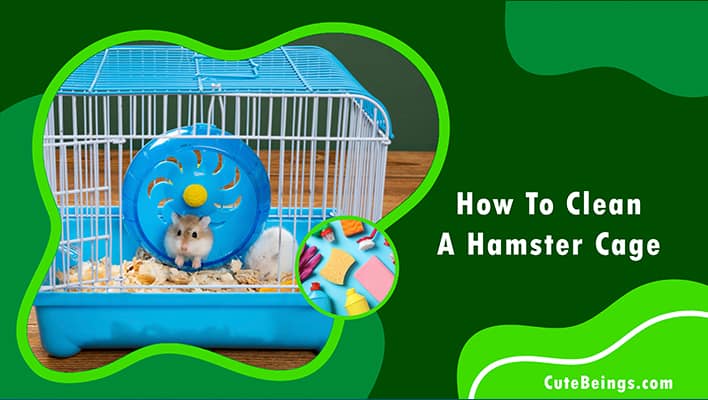Hey there, small animal care experts! Are you looking for the best way to clean your hamster cage? Then look no further, I’m here to help. Cleaning a hamster cage can be a daunting task if you don’t know where to start, but with these step-by-step instructions, it doesn’t have to be complicated. From gathering all of your supplies and preparing the area to actually cleaning out the cage and putting everything back in its place. I’ll walk you through every part of the process so that you can keep your furry friend’s home spick and span at all times.
At first glance, cleaning a hamster cage might seem overwhelming. But trust me when I say that with just a few simple steps, anyone can master this task quickly and easily. You’re going to need some basic materials, like gloves, a scrub brush, soap, and water. plus some time set aside specifically for this job. Once you’ve got those things squared away, we can get started!
Table of Contents
Steps To Clean Hamster Cage
Wire-Top Hamster Cages
When it comes to cleaning a wire-topped hamster cage, safety and convenience are key.
- First, you’ll want to clear out all of the bedding, toys and dishes from your hamster’s living space. Take care when handling your pet as they can be easily frightened during this process.
- Next, you should give the inside of their cage an initial wash using warm water and mild soap or specialized small animal cage cleaner.
- Then take a cloth dipped in white vinegar solution to wipe down the walls of the cage, paying special attention to spots where droppings may have accumulated over time.
- Once that is done, you can use another wet cloth with just plain warm water to rinse off any residue left behind by either the soap or vinegar solution.
- Make sure everything inside is completely dry before returning it back into your pet’s home.
Glass Tanks And Aquariums
Cleaning a glass tank or aquarium is similar to cleaning a wire-top cage, but with some additional steps to consider.
- The first step in cleaning an aquarium is to remove all bedding material and accessories from the tank. Have your hamster relocated safely while you clean their home– it will make things much easier!
- Next, use warm water with mild soap to wipe down every surface of the tank’s interior.
- Rinse thoroughly when finished and allow it time to dry before adding fresh bedding material and accessories back into the tank.
Cleaning out the filter should also occur regularly, as this prevents bacteria buildup, which can harm not only your hamster but other small pets living in the same area too. You should rinse off any hard components, such as activated carbon cartridges, weekly and replace soft foam inserts every four weeks or so, depending on how often they become dirty. Once everything has been cleaned up, it’s time to fill that gorgeous glass habitat with new bedding material, treats, toys, and anything else you want your furry friend to have access to!
Plastic Hamster Cages
- Start by removing all bedding from the bottom of the cage and place it in a sealed bag or container until ready for reuse.
- Next, use warm water and an appropriate solution designed specifically for small animals to thoroughly clean the walls and floors of the cage and any other accessories such as food bowls, toys etc.
- Make sure you rinse everything off with fresh water so that there’s no residue left behind. Once done, replace all items back into the cage before adding new bedding material.
This way your hamster won’t be exposed to any harmful chemicals while they enjoy their home again! With regular cleaning, your hamster will stay healthy and happy in their clean environment – something both you and they deserve!
Cleaning the hamster cage can be a cause for worry. Where should you put your hamster while cleaning its cage?
Do Hamsters Like Their Cage Being Cleaned?
Do hamsters like their cage being cleaned? Absolutely! Most hamsters absolutely love the process of cleaning their cage, and they can be very active participants in this activity. They really enjoy exploring all over the cage while it is being cleaned and often respond to it with excitement. It’s a great opportunity for them to investigate new toys and tunnels as well. Cleaning your pet’s cage will give you an idea of how much enjoyment your little friend gets out of its environment.
Observing your hamster’s reaction during cleaning sessions can be quite amusing. For example, some may seem excited about having more space to explore or when rearranging items in the enclosure. Others might even get territorial if something needs to be moved from one corner of the cage to another! Hamsters have unique personalities that make caring for them so rewarding. Cleaning their cages is just one way we show our appreciation for them.
But keeping in mind regular or frequent cleaning would make them stressed.
Can Hamsters Live In A Dirty Cage?
Yes, hamsters can live in a dirty cage; however, it is not recommended. Living in an unclean environment can cause illness and other unhealthy conditions for your pet. If you do choose to keep your hamster in a dirty cage, it’s important to monitor them closely for signs of distress. Any changes in behavior could indicate an underlying health issue that requires attention. Additionally, the smell from living in a dirty cage will become overwhelming over time and make everyone around uncomfortable. It’s essential to clean your hamster’s cage regularly so they may stay healthy and comfortable. Cleaning the cage on a weekly basis should be enough
How To Clean A Hamster Cage With Babies In It
Cleaning a hamster cage with babies in it is an important yet delicate process. Like any other type of parenting, you need to be mindful and cautious when dealing with the little ones. As a small animal care expert, I’m here to guide you through this task!
Here are some steps on how to clean your hamster cage with babies:
- Remove all food and toys from the cage before beginning the cleaning process.
- Separate the mother and baby if they reside in separate cages so that they do not become stressed out by being put together during the chaos of a deep clean.
- Take everything outside for a thorough washing using warm water and natural soap or disinfectant – but be careful not to submerge any electrical items like heaters, as these must be wiped down only.
- Dry off all objects then place them back into the newly cleaned environment.
- Add fresh bedding such as wood shavings or paper pellets for added comfortability for both parents and their offspring.
- Ensure there’s plenty of ventilation in the enclosure so that everyone can breathe easily.
Cleanliness is key when caring for your furry friends, especially those who have just welcomed new life into their home!
What Happens If You Don’T Clean Your Hamsters Cage?
If you don’t clean your hamster’s cage, it can lead to several health risks for them. Unsanitary conditions can develop quickly in cages that are not cleaned regularly. This is due to the buildup of uncleaned droppings and dirty bedding, which can result in foul odors. These unhealthy living conditions can cause respiratory problems, disease, and even parasites in some cases. Additionally, an accumulation of urine and feces will create a dangerous environment where bacteria can spread throughout the cage easily.
Factors That Affect The Cleaning Frequency
Caring for a hamster is an important responsibility, and part of that includes cleaning its cage. The frequency and depth of the cleanings depend on several factors, such as odor, size, type, number, and environment. It’s essential to understand these components in order to properly care for your pet.
Odor has a huge impact on how often you should clean your hamster’s cage. If the smell becomes too strong or unpleasant, then it’s time to give their home a deep clean right away! Additionally, if there are multiple animals living together in one habitat or if they are especially active creatures then more frequent changes may be necessary to keep them healthy.
The size of the cage can also affect how frequently it needs attention. Smaller enclosures require more regular maintenance since droppings and debris accumulate more quickly than in larger habitats. Furthermore, depending on what type of bedding material you choose. Paper-based products versus wood chips will determine how often you need to change out the contents inside the enclosure.
The amount of creatures inhabiting the space matters too; usually two small rodents like hamsters do not produce enough waste to warrant changing all the bedding regularly (but still pay close attention!).
Lastly, where you place your furry friend affects just how much upkeep is necessary – being near fans or air vents creates dustier conditions faster which requires additional tidying up after some time passes by.
Check out How Often To Clean Hamster Cage article on how frequently you should clean your hamster cage.
Things To Avoid When Cleaning A Hamster Cage
It is important to be aware of some common mistakes made when cleaning a hamster cage. Here are the top 5 things to avoid:
- Cleaning products with strong chemicals – Using harsh cleaners and detergents can cause irritation or respiratory issues for your small pet, so it’s best to use gentle soap and warm water instead.
- Unsafe materials – Avoid using any materials that could potentially harm your little one, such as sharp objects or anything containing toxins.
- Overcrowding – When deep cleaning, make sure you don’t overcrowd their home with too many items that might cause stress.
- Chemicals – Always stay away from toxic substances like aerosols and air fresheners which can be hazardous if inhaled by your hamster.
- Deep cleaning – While it may seem necessary at times, try not to do this too often since it can create an uncomfortable amount of disruption in the environment where they live.
Cleaning a hamster cage shouldn’t have to come at the expense of stressing them out! Knowing what potential risks should be avoided will help you ensure a safe and efficient way to keep your furry friend happy and healthy.
How Can You Clean Your Hamster’S Cage Without Stressing Them?
Once your pet is safely away from any potential danger during the cleaning process, start by removing all bedding material, such as wood shavings or shredded paper towels, used to line the bottom of the cage. Then use warm water mixed with mild soap to carefully wipe down all surfaces within the cage, including walls, floors, and toys. Make sure not to miss any nooks or crannies that may contain dirt and debris! After wiping everything down completely, rinse off all surfaces using clean water and allow them to dry naturally before replacing your pet back into their cage with fresh bedding material.
How To Clean A Hamster Cage After One Dies
Cleaning a hamster cage after one has passed away is not something anyone wants to do, but it must be done. The first step is to remove the dead hamster and place it in a plastic bag for disposal. Once you have removed the deceased hamster from its home, it’s time to start cleaning. You’ll need warm water mixed with mild soap and a scrubbing brush or sponge. Begin by washing out all surfaces of the cage, including any toys your pet may have had inside. Make sure to use different sponges for each surface so that germs don’t spread between them. When finished, rinse off excess soap and dry with soft cloths or paper towels before replacing bedding and toys into the freshly cleaned cage.
What Is The Fastest Way To Clean A Hamster Cage?
The fastest way to clean a hamster cage is surprisingly simple. All you need is some basic supplies, including a new hammock or bedding, and a few minutes of your time. Start by removing any old food and fecal matter from the bottom of the cage. Once that’s done, replace it with fresh bedding material, like pellets or wood shavings. This will help keep the cage smelling fresher for longer periods of time. Next, use an all-purpose cleaner to wipe down the walls and other surfaces in the cage. Finally, give your little friend something fun to play with this could be anything from simple toys to tunnels and ladders!
What Is The Easiest Way To Clean A Hamster Cage?
Cleaning a hamster cage doesn’t have to be a stressful or time-consuming task. In fact, according to research from the National Small Animal Association, up to 45% of all pet hamsters in the United States enjoy being involved with their own cage cleaning process! As an experienced small animal caretaker, I can tell you that it’s important for your furry friend to make sure its home is kept clean and comfortable on a regular basis.
To make this task as stress-free (and fun!) as possible, here are some tips and tricks on how to clean a hamster cage easily:
- First off, it’s best to do frequent spot checks throughout each week – checking areas like food bowls and bedding materials for any signs of dirt or debris buildup.
- Secondly, when it comes time for deep cleaning every few weeks or so – use only non-toxic cleaners that won’t harm your pet if they come into contact with it, and then rinse away any residue using warm water.
- Finally, always keep fresh food and water available during the entire cleaning process so your little one isn’t feeling left out!
Do Hamsters Like It When You Clean Their Cage?
Do hamsters like it when you clean their cage? Yes, they do! In fact, it’s essential for the wellbeing of your pet. A clean and hygienic environment is vital to a healthy and happy hamster. It also makes sure that any mess or odors are kept at bay. To keep your hamster’s home in perfect condition, regular cleaning should take place. The frequency of this will depend on the size of the cage and how many animals live inside; generally speaking, every two weeks should suffice.
When it comes to the actual cleaning process, make sure you have all of the necessary supplies ready before starting. You’ll need gloves, newspaper or towels, a water-based cleaner, paper towels or cloth rags, a sponge or scrub brush (for tougher areas), a vacuum cleaner with a hose attachment (optional), and a small bowl for soap suds. Start by removing all bedding from the cage and disposing of it properly; then use a damp cloth to wipe down everything within reach — walls, top bars, etc. Next up is scrubbing off any stubborn stains or soiled areas using either dishwashing liquid mixed into warm water or a cleanser specifically designed for animal cages. Finally, rinse out with cold water, then dry with a towel or rag before replacing fresh bedding material back in the cage.
Conclusion
As a small animal care expert, I can tell you that cleaning your hamster’s cage is incredibly important for them to live happily and healthily. It may seem like an arduous task at first, but with the right steps and tools it doesn’t have to be difficult.
Your hamster will thank you when they get to enjoy the benefits of a clean home! Not only does it help their overall wellbeing, but many hamsters actually appear to appreciate the effort put into keeping things tidy. some even show signs of excitement as soon as you begin!
So if you’re ready to give your little friend a sparkling new environment, just go through our step-by-step guide on how to clean a hamster cage and don’t forget that however busy life gets sometimes, taking time out every once in awhile for your furry companion really pays off.
Before you go
It is possible to decrease the frequency of cleaning your pet’s cage. Say goodbye to messy cages by reading the Potty Train Your Hamster article.

Hello, my name is James and I’ve been caring for tiny pets for over 14 years with a passion. I enjoy passing on my expertise to other individuals in order for them to have the same amount of enjoyment as I do.




